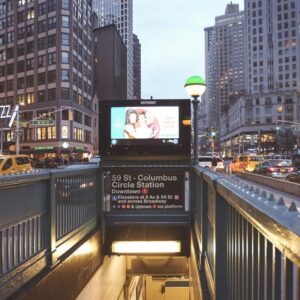The Visual Revolution in Luxury Retail and Auto Showrooms
In the digital age, aesthetics and experience define consumer behavior. Both luxury retail and automotive showrooms compete not just in products, but in how they are visually presented. Traditional signage and bulky displays often interfere with the clean, high-end atmosphere these spaces aim to maintain.
This is where transparent LED display screens redefine expectations. They blend cutting-edge display technology with seamless architectural integration. As a result, they allow stores and showrooms to communicate, advertise, and captivate—without blocking light or disrupting design.
1. What Are Transparent LED Display Screens?
Transparent LED screens are see-through digital display solutions. They use narrow-pitch LED strips arranged on clear panels. The design allows viewers to see both the displayed content and the background behind the screen.
Typically installed behind glass facades, large windows, or open retail fronts, these displays project vibrant visuals while preserving spatial transparency. Because they allow up to 90% light transmission, they are ideal for settings that rely heavily on natural lighting and clean design.
2. The Aesthetic Edge: Clean Design Meets Dynamic Display
Luxury spaces value elegance, minimalism, and openness. Transparent LED display screens align with these principles. Unlike bulky digital panels, they maintain the clean geometry of the space.
In automotive showrooms, these displays highlight models, promotions, or even interactive content, without blocking the vehicle view. In luxury retail, they convey brand visuals, runway videos, or limited-edition teasers, all while keeping store interiors visually accessible.
Furthermore, their “floating content” effect provides a futuristic, premium atmosphere that resonates with affluent customers.
3. Enhancing the Customer Journey Through Visual Storytelling
The customer experience begins before a customer even steps inside. Transparent displays turn glass walls into digital invitations.
For example:
Car showrooms use them to display rotating 3D renders or engine specifications.
Fashion boutiques feature curated collections or live-streamed events.
Because transparent LED display screens can be controlled remotely, content can be updated instantly to reflect seasons, events, or promotions. This helps luxury brands stay timely, personalized, and relevant.
4. Maximizing Natural Light and Visibility
Transparent displays let natural light flood indoor spaces. This is crucial in high-end design where ambiance matters. Natural lighting:
Enhances product colors
Improves customer mood
Reduces reliance on artificial lighting
More importantly, transparent LED panels don’t obstruct the view from inside to outside. Customers inside can see out. Passersby can glimpse in. This maintains an open atmosphere, which has been shown to increase foot traffic and engagement.
5. Technical Advantages That Serve Premium Spaces
Several technical features make transparent LED screens especially suited for car showrooms and luxury retail:
- High Transparency (up to 90%)
- Slim Profile (under 10mm)
- Lightweight Design (under 10kg/m²)
- High Brightness (≥5000nits for daylight visibility)
- Modular Installation
- Remote Content Management
These traits ensure transparent LED display screens don’t just look good—they function seamlessly in fast-paced, high-end commercial environments.
6. Easy Integration Into Existing Architecture
Many luxury showrooms are located in malls, airports, or standalone glass buildings. Transparent LED panels install directly onto existing glass facades without structural modification.
This offers significant advantages:
- No loss of real estate space
- Minimal interruption to operations
- Architectural integrity remains intact
Even better, screens can be customized to match the window’s shape and size. Curved transparent displays are also possible for creative storefronts.
7. Use Cases That Highlight Impact
Automotive Showrooms
- Display technical specs near each car
- Run brand campaigns or seasonal ads
- Highlight special offers without obstructing views
Luxury Retail Spaces
- Display fashion runways on store windows
- Run countdowns for new product drops
- Broadcast real-time social media feeds
These use cases show that transparent LED display screens are more than advertising—they’re integral to the space’s visual identity.
8. Sustainability and Energy Efficiency
Despite their power, transparent LEDs are more energy-efficient than LCD video walls. With lower power consumption, these screens support sustainability goals in premium commercial spaces.
Moreover, they produce less heat, reducing cooling costs. For LEED-certified buildings, this is a major advantage.
Conclusion: Transparency, Technology, and Transformation
The luxury sector constantly seeks to blend elegance with innovation. Transparent LED display screens deliver both. They preserve space aesthetics, enhance the customer experience, and provide versatile digital content opportunities.
In car showrooms and premium retail spaces, these screens are not just tools—they’re visual assets. With their ability to project compelling content without sacrificing transparency, they are redefining how modern luxury is experienced.
By adopting transparent LED display screens, brands showcase more than products—they showcase vision.




